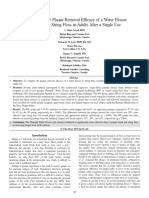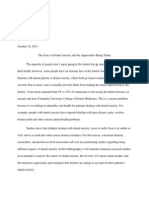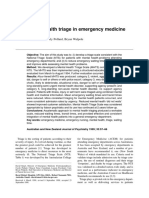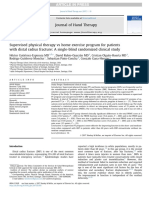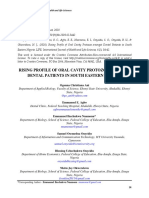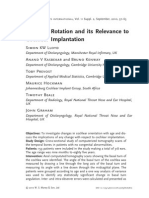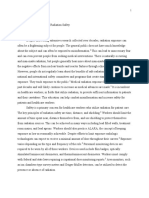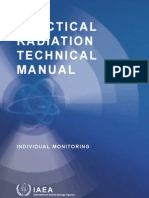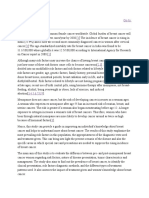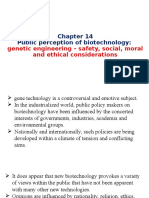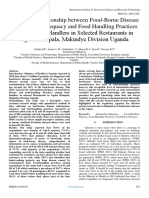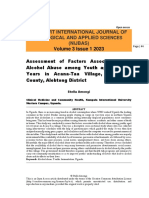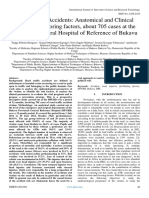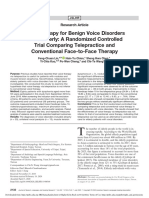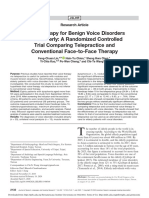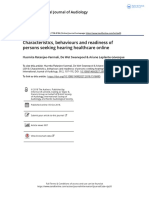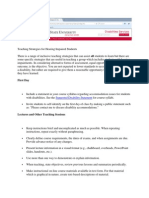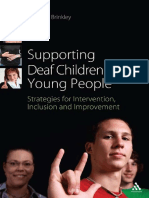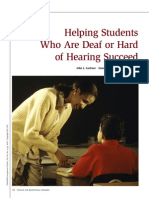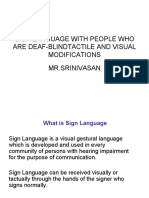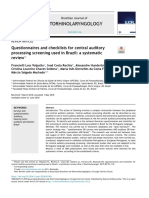Professional Documents
Culture Documents
Impact of Amplifications On Hearing Aid User Among Middle Adulthood
Original Title
Copyright
Available Formats
Share this document
Did you find this document useful?
Is this content inappropriate?
Report this DocumentCopyright:
Available Formats
Impact of Amplifications On Hearing Aid User Among Middle Adulthood
Copyright:
Available Formats
Volume 8, Issue 1, January – 2023 International Journal of Innovative Science and Research Technology
ISSN No:-2456-2165
Impact of Amplifications on Hearing Aid User among
Middle Adulthood
Samina Ahmad; Dr. Shahid Majeed; Fasiha Iftikhar; Hasmain Ahmad
Bahawalpur Medical College & Hospital
Abstract:- of hearing loss in the world is (WHO) 56% in males and 44
Background: Around the word hearing loss is became a in females.
concern topic. To overcome from this science introduce
multiple hearing aid categories with a lots of benefit. With (6)Humans have a fairly small range of hearing
the increase hear loss, amplifications play a significant compared to other species; the frequencies that we can hear
role for the users. The purpose of the study is to find out are between 20 Hz and 20,000 Hz, this is known as the audio
the satisfaction level of clients who use amplifications in or sonic range. The frequencies above that range are known
their routine life, Also effect of different amplification as ultrasonic and those below are known as infrasonic. The
among different individual. These hearing aids are auditory system serves functions other than speech listening,
envisioned to help user with perceived mild to moderate such as tracking sounds. There are three types of hearing loss.
hearing loss. Hearing aids are available from a hearing Conductive hearing loss, sensorineural hearing loss, and
health professional that will program according to unit of
hearing loss. Method: The cross sectional study conducted mixed hearing loss. (4)The most common categories of
to justify the research by using (SADL) satisfaction with hearing loss classification are mild, moderately severe,
amplification in daily life questionnaire. Sample of 100 severe, and profound hearing loss.
populations male and female were selected of around
middle age “40-60”. Data were collected from different If one has a mild HL, the quietest sounds individual can
private hospitals and clinics from different cities hear with our best hearing are between 25 and 40 dB with a
“Bahawalpur, Multan and Lahore. Descriptive Statistics, moderate HL, the quietest sounds one can hear with our best
Pearson Product Moment Correlation, Independent ear are between 41 and 55dB. If one has a severe moderate
Sample t-test and Linear Multiple analysis were used to HL, the quietest sounds an individual can hear with the ear
analyse the data. Results: Result revealed a positive are between 56 and 90 dB, and with SHL; the quietest sounds
correlated significant value among different category of one can hear are between 71 and 90 dB and more, and above
amplifications. Among all hearing types, the people using 91 dB is profound HL.
BTE (Behind the Ear) were mostly satisfied with their
devices. Age also revealed a significant relationship, (7)Many factors will interfere with patient satisfaction
people aged 40-45 were mostly satisfied with every and benefit from an earpiece, Lack of incentives, the fear of
category of hearing aid. Hearing aid type ITC “In the stigmatization, low expectations of benefits, or failure to
canal” revealed a negative significance correlation. accept are barriers that remain. Medical professionals need to
Conclusion: hearing aid can improve the quality of life for demonstrate to both the communities’ resource provider, the
hearing aid user and satisfaction level increases among service that they offer, the client's functional status, and
hearing aid users with the passage of time. quality of Life. In the setting of sound rehabilitation, the result
measure emerged as effective in this method, specific
Keywords:- Hearing Aid, Amplification, Satisfaction with interventions such as hearing aids work to get positive results
Amplification in Daily Life. for the client. The client's information about the benefit of
interventions and techniques promotes the decision- making
I. INTRODUCTION based on data. (5) (6)
(1)Hearing impairment is a major concern around the Hearing aids help to communicate with other clients,
world. Hearing impairment to almost any extent can be regular daily activities, and decrease in psychosocial society
improved with a hearing aid. Evidence highlights the effects of hearing loss. This aid partially overcomes the
importance of hearing aids to improve the quality of daily life defects associated with hearing loss.
of the person. Hearing loss is a disorder that affects cognitive,
behavioral, and social functions. The use of hearing aids in II. METHOD
such individuals improves the general quality of life.
The study was conducted from December 2021 to July
(2)Disabling Hearing Loss is defined as hearing loss of 2022 after taking permission from relevant department. It was
more than 40 dB in the better auditory ear in adults (15 years Descriptive cross sectional research design and a non-
old or above =) and children (0-14 years) and the prevalence probability purposively sampling technique used to recruit
IJISRT23JAN905 www.ijisrt.com 804
Volume 8, Issue 1, January – 2023 International Journal of Innovative Science and Research Technology
ISSN No:-2456-2165
data. The sample size was calculated through G-Power movement correlation was used to study the effect and
analysis with 95% confidence interval, error of margin 5% relationship of variable.
and 50% response distribution. Calculated sample size was
100. Age range of middle adulthood was 40-60. Male and III. RESULT
female were equally selected for research. “Satisfaction with
amplification in daily life (SADL) scale was used for this The purpose of present study is to find the Level of
study. It consists on 15 items divided into 4 subscales. It is a satisfaction of hearing aid users with amplification in daily
7-point Likert scale and the value choose for each scale was life. Total number of patients were n= 100. The study
“A for never, B for somewhat frequent, C for frequent, D for comprised 62% males and 38% percent females around the
always and so on” the internal consistency was found α=.80 middle age and the mean age of participant is 47%. Result
and in this study was α=.90. Data were analyzed through reveals the positive correlated significant value at the 0.01
SPSS-21. Descriptive statistic was used to study the level (2-tailed).
demographic characteristics of the sample. Pearson product
Table I: Gender type of Hearing Aid Usage
Gender Behind the ear HA In the ear HA In the canal HA Completely in canal HA
Males (62) 32 13 11 06
Females (38) 16 03 13 06
Table I Shows the gender types of hearing aid usage females (38) patients were using behind the ear (16), in the
n=100males patients were using behind the ear HA (32), in canal HA (03), in the canal (13) and completely in the canal
the canal HA (13) and completely in canal HA (06) n=100 HA (06).
Table II: Duration of HA usages
Time Frequency Percentage Cumulative percentage
0-3 months 29 29% 29.0
3-6 months 12 12% 41.0
1-2 years 40 40% 81.0
2-5 years 19 19% 100.0
Table II Shows the patients n=100 HA usage among 0-3 months users was 29%, among 3-6 months users was 12%, among
1-2 years users was 40% and among 2-5 years users was 19%.
Fig 1 Degree of hearing loss
Figure 1 shows the degree of hearing loss. Pie chart shows the degree of hearing loss found as 28% moderate level of hearing
loss, 43% was moderate to severe hearing loss and 29% was severe degree of hearing loss.
Table III Correlation
Pearson CorrelationSig. (2- .027 .404** .462** 1 .332**
tailed)
Personal Image .791 .000 .000 .001
N 100 100 100 100 100
Pearson Correlation .355** .726** .481** .332** 1
Global Score
IJISRT23JAN905 www.ijisrt.com 805
Volume 8, Issue 1, January – 2023 International Journal of Innovative Science and Research Technology
ISSN No:-2456-2165
Sig. (2-tailed) .000 .000 .000
.001
N 100 100 100 100
100
**. Correlation is significant at the 0.01 level (2-tailed).
Table IV-7 Correlations
positive service and Negative Personal Global Score
Effect cost Factors Image
1 .544** .006 .027 .355**
Pearson Correlation
PositiveEffect Sig. (2-tailed) .000 .953 .000
N 100 100 100 100
.79
1 100
Service andCost .544** 1 .271** .404 ** .726**
Pearson Correlation
Sig. (2-tailed) .000 .006 .000
N 100 100 100 .00 100
100
.006 .271** 1 .462** .481**
Pearson Correlation
NegativeFactors Sig. (2-tailed) .953 .006 .000
N 100 100 100 .000 100
100
IV. DISCUSSION Evidence shows that implementing a worldwide
rehabilitation program that support adults with hearing
The present study aimed to find the amplifications on disabilities and their families, tackle disadvantages and
hearing aid users among middle adulthood aged 40-60. The obstacles due to defects recognized as lacking in hearing aids.
SADL tool has 15 questions and divided into four subscales An integralpart of the problem is to prevent social isolation to
Positive Effects, Services and Costs, Negative Factors and the patient for verbal communication of the world.
Personal Image. (8)Prior study shows that the data is very (18)Literatures show that its effect typically appears after one
important to follow the auditory rehabilitation program year or several years use of monaural HA in children and
including home listening, guidance and counselling so that adults. The hearing level and degree of asymmetry are big
the patient can have realistic expectations beyond the problems; significantly big benefits were obtained from
selection of the most technically relevant hearing aids. binaural amplification. This was deemed to be due to central
(9)Many authors suggest that it is a determinant of satisfaction aggregation. It has been concluded that amplification of both
ears should be attempted in both ears, of subjects with severe
of hearing aid users it is closely related to recognition of hearing impairment.
product performance. Evidence shows that shortterm benefits
of hearing aids is most prominent in the handicap person with V. CONCLUSION
disabilities and increasing attention well life.
Hearing aid can improve the quality of life for hearing
The result shows that males have severe hearing loss. aid user and satisfaction level increases among hearing aid
(12)A study has conducted in Australia and show differences users with the passage of time. Due to the findings of the
in male and females hearing loss. Numbers of males facing current research, degree of hearing loss, age and type of
hearing problems are greater than females. The present result hearing aid has shown positive influence on the usage, the
shows that hearing loss is increasing with age. A similarstudy satisfaction and the quality of life for people with hearing
shows that people are suffering from different diseases such problems. In addition, degree of subjective awareness of
as stress, psychological disorder, diabetes, mellitus, high disability caused by hearing loss meaningfully affects the use
protection etc. which are contributing factors of hearing loss. of a hearing aid and satisfaction of patients.
The current study shows the satisfaction of the HA
users. (16) A similar study shows factors associated with high
level of satisfaction whose temporality wasnot achieved and
perceptive patients were in a good general health status.
IJISRT23JAN905 www.ijisrt.com 806
Volume 8, Issue 1, January – 2023 International Journal of Innovative Science and Research Technology
ISSN No:-2456-2165
REFERENCES [16]. Beck LB. The role of outcomes data in health-care
resource allocation. Ear and hearing. 2000 Aug;21(4
[1]. World Health Organization. WHO global estimates on Suppl):89S-96S
prevalence of hearing loss. Geneva: World Health [17]. .FabryDA, Jacobson GP, Newman CW. The
Organization. 2012. development of the three- clinic hearing aid selection
[2]. Higgs DM. Neuroethology and sensory ecology of profile. Correspondênciapessoal. Mai. 2000.
teleost ultrasound detection. In The senses of fish 2004 [18]. Weinstein BE. Outcome measures in the hearing aid
(pp. 173-188). Springer, Dordrecht. fitting/selection process. Trends in Amplification. 1997
[3]. Adams PF, Marano MA. Current estimates from the Dec;2(4):117-37.
National Health Interview Survey, 1994. Vital and
health statistics. Series 10, Data from the National
Health Survey. 1999 Dec (193 Pt 1)
[4]. ( Byrne& Noble, 1998) Byrne D, Noble W. Optimizing
sound localization with hearing aids. Trends in
Amplification. 1998 Jun ;3(2):51-73.
[5]. Uriarte M, Denzin L, Dunstan A, Sellars J, Hickson L.
Measuring hearingaid outcomes using the Satisfaction
with Amplification in Daily Life(SADL) questionnaire:
Australian data. Journal of the American Academy of
Audiology. 2005 Jun 1;16 (6):383-402.
[6]. ( Stephens SD, Callaghan DE, Hogan S, Meredith R,
Rayment A, DavisAC. Hearing disability in people aged
50-65: effectiveness and acceptability of rehabilitative
intervention. BMJ. 1990 Feb 24;300(6723):508-11.
[7]. Byrne D, Dillon H, Ching T, Katsch R, Keidser G.
NAL-NL1 procedure for fitting nonlinear hearing aids:
characteristics and comparisons with other procedures.
Journal of the American academy of audiology. 2001Jan
1;12(1).
[8]. Penteado SP, Bento RF, Battistella LR, Silva SM,
Sooful P. Use of the satisfaction with amplification in
daily life questionnaire to assess patient satisfaction
following remote hearing aid adjustments (telefitting).
JMIR medical informatics. 2014 Jul;2(2).
[9]. HOSFORD-DUNN HO, HUCH JL. Hearing Aid User
Attitudes. Textbook of Hearing Aid Amplification.
2000:467.
[10]. Nabelek AK, Freyaldenhoven MC, Tampas JW,
Burchfield SB,Muenchen RA. Acceptable noise level as
a predictor of hearing aid use.Journal of the American
Academy of Audiology. 2006 Oct 1;17(9):626- 39.
[11]. Freyaldenhoven MC, Nabelek AK, Tampas JW.
Relationship between acceptable noise level and the
abbreviated profile of hearing aid benefit.
[12]. Journal of Speech, Language, and Hearing Research.
2008 Feb 1;51(1):136-46.
[13]. Rein S, Reisslein M. Identifying the classical music
composition of an unknown performance with wavelet
dispersion vector and neural nets. Information Sciences.
2006 Jun 22;176(12):1629-55.
[14]. Lambrou T, Kudumakis P, Speller R, Sandler M, Linney
A. Classification of audio signals using statistical
features on time and wavelet transform domains.
InAcoustics, Speech and Signal Processing, 1998.
Proceedings of the 1998 IEEE International Conference
on 1998 May 12(Vol. 6, pp. 36213624). IEEE.
[15]. Martin KD, Kim YE. 2pMU9. Musical instrument
identification: A patternrecognition approach.
InPresented at the 136th meeting of the Acoustical
Society of America 1998 Oct 13.
IJISRT23JAN905 www.ijisrt.com 807
You might also like
- Quiet Time For Patients in Acute CareDocument24 pagesQuiet Time For Patients in Acute Careapi-354868439No ratings yet
- 54 A 0Document6 pages54 A 0Gabriela Marie CruzNo ratings yet
- Improving Patient Communication Standards with Evidence-Based PracticeDocument42 pagesImproving Patient Communication Standards with Evidence-Based PracticeSri EndriyaniNo ratings yet
- Practice Exam 1Document5 pagesPractice Exam 1Anonymous jSTkQVC27bNo ratings yet
- CPQ810Document7 pagesCPQ810Nurhaslina HasNo ratings yet
- Correlation Between Family Support and Quality of Life Among Hypertensive PatientsDocument3 pagesCorrelation Between Family Support and Quality of Life Among Hypertensive Patientsrizky ayu100% (1)
- Experimental Gingivitis in Man: Harald Löe, Else Theilade, S. Börglum Jensen, 1965Document15 pagesExperimental Gingivitis in Man: Harald Löe, Else Theilade, S. Börglum Jensen, 1965Andy HeNo ratings yet
- Clermidi2013 PDFDocument10 pagesClermidi2013 PDFDaffa ArdhiNo ratings yet
- Annotated Bibliography FinalDocument12 pagesAnnotated Bibliography FinalkevinbuscemiNo ratings yet
- Star Primer 2014 InvitationDocument4 pagesStar Primer 2014 InvitationBhavik ChopdaNo ratings yet
- J Parenter Enteral Nutr - 2022 - Flordel S Lasierra - Enteral Nutrition in Critically Ill Patients Under Vasoactive DrugDocument11 pagesJ Parenter Enteral Nutr - 2022 - Flordel S Lasierra - Enteral Nutrition in Critically Ill Patients Under Vasoactive DrugROBERTO CARLOS BLANQUICETT CORTINANo ratings yet
- Royal Hobart Mental Health Triage ScaleDocument10 pagesRoyal Hobart Mental Health Triage ScaleJay UnniNo ratings yet
- Global Cancer Transitions According To The Human Development Index (2008-2030) A Population-Based StudyDocument12 pagesGlobal Cancer Transitions According To The Human Development Index (2008-2030) A Population-Based StudyCristian Gutiérrez VeraNo ratings yet
- Career Research PaperDocument3 pagesCareer Research Paperapi-267168900100% (1)
- DQoL Jacobson 1988 PDFDocument8 pagesDQoL Jacobson 1988 PDFeunikieNo ratings yet
- 10 1016@j JHT 2017 02 001 PDFDocument10 pages10 1016@j JHT 2017 02 001 PDFGusti Ayu KrisnayantiNo ratings yet
- Rising Profile of Oral Cavity Protozoa Amongst Dental Patients in South Eastern NigeriaDocument9 pagesRising Profile of Oral Cavity Protozoa Amongst Dental Patients in South Eastern NigeriaGlobal Research and Development ServicesNo ratings yet
- Cochlear Rotation and Its RelevanceDocument7 pagesCochlear Rotation and Its RelevanceDrTarek Mahmoud Abo KammerNo ratings yet
- Carmignani 2018Document9 pagesCarmignani 2018Khumaira SantaNo ratings yet
- Lettre de Hollingsworth À Consolato Maria SergiDocument6 pagesLettre de Hollingsworth À Consolato Maria SergiLeMonde.frNo ratings yet
- Radiation Safety PaperDocument3 pagesRadiation Safety Paperapi-568864349100% (1)
- Rad Safety Paper FinalDocument4 pagesRad Safety Paper Finalapi-711343423No ratings yet
- Comparison Ofarch Width Dimensions Among Class I and Class II Division 1 Malocclusion Groups - Journal of The Pakistan Dental AssociationDocument11 pagesComparison Ofarch Width Dimensions Among Class I and Class II Division 1 Malocclusion Groups - Journal of The Pakistan Dental AssociationSyed Mohammad Osama AhsanNo ratings yet
- Practical Radiation Technical Manual: Individual MonitoringDocument67 pagesPractical Radiation Technical Manual: Individual Monitoringjiar001No ratings yet
- New Microsoft Office Word DocumentDocument11 pagesNew Microsoft Office Word DocumentMihaela AndreiNo ratings yet
- Speech AudiometryDocument17 pagesSpeech AudiometryPero Kvržica100% (1)
- Zehnder - The Safety of RadiationDocument5 pagesZehnder - The Safety of Radiationapi-692126663No ratings yet
- Central Auditory Processing - Syllabus Fall 2016Document28 pagesCentral Auditory Processing - Syllabus Fall 2016api-349133705No ratings yet
- Knowledge, Attitude and Practice Towards COVID-19 Vaccination Among Adults of Sullia Taluk in Dakshin Kannada District of Karnataka - A Community Based Survey)Document8 pagesKnowledge, Attitude and Practice Towards COVID-19 Vaccination Among Adults of Sullia Taluk in Dakshin Kannada District of Karnataka - A Community Based Survey)International Journal of Innovative Science and Research TechnologyNo ratings yet
- Public Perception of Biotechnology:: Genetic Engineering - Safety, Social, Moral and Ethical ConsiderationsDocument18 pagesPublic Perception of Biotechnology:: Genetic Engineering - Safety, Social, Moral and Ethical ConsiderationsHayderNo ratings yet
- DysphagiaDocument7 pagesDysphagiaherlizarefrianiNo ratings yet
- Quality Control of CTDocument6 pagesQuality Control of CTFrancisco HernandezNo ratings yet
- Anc Who 2019Document68 pagesAnc Who 2019Pika LubisNo ratings yet
- ICRU 29 Dose Specification For Reporting External Beam Therapy With Photons and Electrons PDFDocument29 pagesICRU 29 Dose Specification For Reporting External Beam Therapy With Photons and Electrons PDFDiego MauricioNo ratings yet
- FEES6Document36 pagesFEES6Justy GuavaNo ratings yet
- Concepts and Challenges in The Use of Knowledge-Attitude-Practice Surveys: Literature ReviewDocument7 pagesConcepts and Challenges in The Use of Knowledge-Attitude-Practice Surveys: Literature Reviewrashed2112000No ratings yet
- Epidemio - Clinical Profile and Management of Female Infertility in The City of IsiroDocument5 pagesEpidemio - Clinical Profile and Management of Female Infertility in The City of IsiroInternational Journal of Innovative Science and Research TechnologyNo ratings yet
- Guidelines For Speech-Language PathologistsDocument37 pagesGuidelines For Speech-Language PathologistsMilia Quin Ri100% (1)
- Maternal Practices Towards Dental Treatment of Primary School Children After The Emergence of Covid 19Document6 pagesMaternal Practices Towards Dental Treatment of Primary School Children After The Emergence of Covid 19International Journal of Innovative Science and Research TechnologyNo ratings yet
- ProposalDocument22 pagesProposalKD CarlosNo ratings yet
- Evaluation of Aural Manifestations in Temporo-Mandibular Joint DysfunctionDocument5 pagesEvaluation of Aural Manifestations in Temporo-Mandibular Joint DysfunctionJay JoslinNo ratings yet
- Efficacy of Extract of Pelargonium Sidoides in Children With Acute Non-Group A Beta-Hemolytic Streptococcus Tonsillopharyngitis: A Randomized, Double-Blind, Placebo-Controlled TrialDocument11 pagesEfficacy of Extract of Pelargonium Sidoides in Children With Acute Non-Group A Beta-Hemolytic Streptococcus Tonsillopharyngitis: A Randomized, Double-Blind, Placebo-Controlled TrialInnoVision Health Media100% (1)
- InTech-Molar Incisor Hypomineralization Morphological Aetiological Epidemiological and Clinical ConsiderationsDocument25 pagesInTech-Molar Incisor Hypomineralization Morphological Aetiological Epidemiological and Clinical ConsiderationsNeagu EmaNo ratings yet
- LIPUS TRUST StudyDocument7 pagesLIPUS TRUST StudymedtechyNo ratings yet
- Measuring Oral Health and Quality of LifeDocument172 pagesMeasuring Oral Health and Quality of LifeCalin Dragoman100% (1)
- Radiation Safety For General Public WordDocument5 pagesRadiation Safety For General Public Wordapi-527782385No ratings yet
- Factors Influencing Utilization of Prevention of Mother To Child Transmission (PMTCT) Services Among Pregnant Women Attending Ante-Natal ClinicDocument6 pagesFactors Influencing Utilization of Prevention of Mother To Child Transmission (PMTCT) Services Among Pregnant Women Attending Ante-Natal ClinicIPROJECCT100% (1)
- Predicting Relationship Between Food-Borne Disease Information-Adequacy and Food Handling Practices Among Food-Handlers in Selected Restaurants in Ggaba Kampala, Makindye Division UgandaDocument8 pagesPredicting Relationship Between Food-Borne Disease Information-Adequacy and Food Handling Practices Among Food-Handlers in Selected Restaurants in Ggaba Kampala, Makindye Division UgandaInternational Journal of Innovative Science and Research TechnologyNo ratings yet
- Health Policy, Laws and Regulatory Issues Ppt. (Autosaved) (Autosaved)Document22 pagesHealth Policy, Laws and Regulatory Issues Ppt. (Autosaved) (Autosaved)Eman RajpootNo ratings yet
- Critical Appraisal For Speech and Language Therapists: Observational StudiesDocument6 pagesCritical Appraisal For Speech and Language Therapists: Observational StudiesSpeech & Language Therapy in PracticeNo ratings yet
- Curtailing HIVAIDS Spread Impact of Religious LeadersDocument4 pagesCurtailing HIVAIDS Spread Impact of Religious LeadersKIU PUBLICATION AND EXTENSIONNo ratings yet
- Prevalence of Schizophrenia Among Patients Admitted Into Neuro-Psychiatric Hospital, Rumuigbo, Port Harcourt, Rivers State, NigeriaDocument9 pagesPrevalence of Schizophrenia Among Patients Admitted Into Neuro-Psychiatric Hospital, Rumuigbo, Port Harcourt, Rivers State, NigeriaSteven JonesNo ratings yet
- Assessment of Factors Associated With Alcohol Abuse Among Youth Aged (15-25) Years in Acana-Taa Village, Aloi Sub-County, Alebtong DistrictDocument7 pagesAssessment of Factors Associated With Alcohol Abuse Among Youth Aged (15-25) Years in Acana-Taa Village, Aloi Sub-County, Alebtong DistrictKIU PUBLICATION AND EXTENSIONNo ratings yet
- Road Traffic Accidents Anatomical and Clinical Lesions and Favoring Factors, About 705 Cases at The Provincial General Hospital of Reference of BukavuDocument11 pagesRoad Traffic Accidents Anatomical and Clinical Lesions and Favoring Factors, About 705 Cases at The Provincial General Hospital of Reference of BukavuInternational Journal of Innovative Science and Research TechnologyNo ratings yet
- Master Manual 6-27-11Document194 pagesMaster Manual 6-27-11Mihai GrigorasNo ratings yet
- Voice Therapy For Benign Voice Disorders in The Elderly: A Randomized Controlled Trial Comparing Telepractice and Conventional Face-to-Face TherapyDocument9 pagesVoice Therapy For Benign Voice Disorders in The Elderly: A Randomized Controlled Trial Comparing Telepractice and Conventional Face-to-Face TherapyBhargavi GNo ratings yet
- 2020 - JSLHR-19-00364 LecturaDocument9 pages2020 - JSLHR-19-00364 LecturaLuis.fernando. GarciaNo ratings yet
- 2020 The Impact of Hearing Aids On Quality of Life of HearingDocument5 pages2020 The Impact of Hearing Aids On Quality of Life of HearingRuben Eliud Pineda BadilloNo ratings yet
- Acs 2 PDFDocument10 pagesAcs 2 PDFCarolina UrrutiaNo ratings yet
- Prevalence and Pattern of Using Headphones and ItsDocument5 pagesPrevalence and Pattern of Using Headphones and ItsAbi RajanNo ratings yet
- Parastomal Hernia: A Case Report, Repaired by Modified Laparascopic Sugarbaker TechniqueDocument2 pagesParastomal Hernia: A Case Report, Repaired by Modified Laparascopic Sugarbaker TechniqueInternational Journal of Innovative Science and Research TechnologyNo ratings yet
- Smart Health Care SystemDocument8 pagesSmart Health Care SystemInternational Journal of Innovative Science and Research TechnologyNo ratings yet
- Visual Water: An Integration of App and Web to Understand Chemical ElementsDocument5 pagesVisual Water: An Integration of App and Web to Understand Chemical ElementsInternational Journal of Innovative Science and Research TechnologyNo ratings yet
- Air Quality Index Prediction using Bi-LSTMDocument8 pagesAir Quality Index Prediction using Bi-LSTMInternational Journal of Innovative Science and Research TechnologyNo ratings yet
- Smart Cities: Boosting Economic Growth through Innovation and EfficiencyDocument19 pagesSmart Cities: Boosting Economic Growth through Innovation and EfficiencyInternational Journal of Innovative Science and Research TechnologyNo ratings yet
- Parkinson’s Detection Using Voice Features and Spiral DrawingsDocument5 pagesParkinson’s Detection Using Voice Features and Spiral DrawingsInternational Journal of Innovative Science and Research TechnologyNo ratings yet
- Predict the Heart Attack Possibilities Using Machine LearningDocument2 pagesPredict the Heart Attack Possibilities Using Machine LearningInternational Journal of Innovative Science and Research TechnologyNo ratings yet
- Impact of Silver Nanoparticles Infused in Blood in a Stenosed Artery under the Effect of Magnetic Field Imp. of Silver Nano. Inf. in Blood in a Sten. Art. Under the Eff. of Mag. FieldDocument6 pagesImpact of Silver Nanoparticles Infused in Blood in a Stenosed Artery under the Effect of Magnetic Field Imp. of Silver Nano. Inf. in Blood in a Sten. Art. Under the Eff. of Mag. FieldInternational Journal of Innovative Science and Research TechnologyNo ratings yet
- An Analysis on Mental Health Issues among IndividualsDocument6 pagesAn Analysis on Mental Health Issues among IndividualsInternational Journal of Innovative Science and Research TechnologyNo ratings yet
- Compact and Wearable Ventilator System for Enhanced Patient CareDocument4 pagesCompact and Wearable Ventilator System for Enhanced Patient CareInternational Journal of Innovative Science and Research TechnologyNo ratings yet
- Implications of Adnexal Invasions in Primary Extramammary Paget’s Disease: A Systematic ReviewDocument6 pagesImplications of Adnexal Invasions in Primary Extramammary Paget’s Disease: A Systematic ReviewInternational Journal of Innovative Science and Research TechnologyNo ratings yet
- Terracing as an Old-Style Scheme of Soil Water Preservation in Djingliya-Mandara Mountains- CameroonDocument14 pagesTerracing as an Old-Style Scheme of Soil Water Preservation in Djingliya-Mandara Mountains- CameroonInternational Journal of Innovative Science and Research TechnologyNo ratings yet
- Exploring the Molecular Docking Interactions between the Polyherbal Formulation Ibadhychooranam and Human Aldose Reductase Enzyme as a Novel Approach for Investigating its Potential Efficacy in Management of CataractDocument7 pagesExploring the Molecular Docking Interactions between the Polyherbal Formulation Ibadhychooranam and Human Aldose Reductase Enzyme as a Novel Approach for Investigating its Potential Efficacy in Management of CataractInternational Journal of Innovative Science and Research TechnologyNo ratings yet
- Insights into Nipah Virus: A Review of Epidemiology, Pathogenesis, and Therapeutic AdvancesDocument8 pagesInsights into Nipah Virus: A Review of Epidemiology, Pathogenesis, and Therapeutic AdvancesInternational Journal of Innovative Science and Research TechnologyNo ratings yet
- Harnessing Open Innovation for Translating Global Languages into Indian LanuagesDocument7 pagesHarnessing Open Innovation for Translating Global Languages into Indian LanuagesInternational Journal of Innovative Science and Research TechnologyNo ratings yet
- The Relationship between Teacher Reflective Practice and Students Engagement in the Public Elementary SchoolDocument31 pagesThe Relationship between Teacher Reflective Practice and Students Engagement in the Public Elementary SchoolInternational Journal of Innovative Science and Research TechnologyNo ratings yet
- Investigating Factors Influencing Employee Absenteeism: A Case Study of Secondary Schools in MuscatDocument16 pagesInvestigating Factors Influencing Employee Absenteeism: A Case Study of Secondary Schools in MuscatInternational Journal of Innovative Science and Research TechnologyNo ratings yet
- Dense Wavelength Division Multiplexing (DWDM) in IT Networks: A Leap Beyond Synchronous Digital Hierarchy (SDH)Document2 pagesDense Wavelength Division Multiplexing (DWDM) in IT Networks: A Leap Beyond Synchronous Digital Hierarchy (SDH)International Journal of Innovative Science and Research TechnologyNo ratings yet
- Diabetic Retinopathy Stage Detection Using CNN and Inception V3Document9 pagesDiabetic Retinopathy Stage Detection Using CNN and Inception V3International Journal of Innovative Science and Research TechnologyNo ratings yet
- Advancing Healthcare Predictions: Harnessing Machine Learning for Accurate Health Index PrognosisDocument8 pagesAdvancing Healthcare Predictions: Harnessing Machine Learning for Accurate Health Index PrognosisInternational Journal of Innovative Science and Research TechnologyNo ratings yet
- Auto Encoder Driven Hybrid Pipelines for Image Deblurring using NAFNETDocument6 pagesAuto Encoder Driven Hybrid Pipelines for Image Deblurring using NAFNETInternational Journal of Innovative Science and Research TechnologyNo ratings yet
- Formulation and Evaluation of Poly Herbal Body ScrubDocument6 pagesFormulation and Evaluation of Poly Herbal Body ScrubInternational Journal of Innovative Science and Research TechnologyNo ratings yet
- The Utilization of Date Palm (Phoenix dactylifera) Leaf Fiber as a Main Component in Making an Improvised Water FilterDocument11 pagesThe Utilization of Date Palm (Phoenix dactylifera) Leaf Fiber as a Main Component in Making an Improvised Water FilterInternational Journal of Innovative Science and Research TechnologyNo ratings yet
- The Making of Object Recognition Eyeglasses for the Visually Impaired using Image AIDocument6 pagesThe Making of Object Recognition Eyeglasses for the Visually Impaired using Image AIInternational Journal of Innovative Science and Research TechnologyNo ratings yet
- The Impact of Digital Marketing Dimensions on Customer SatisfactionDocument6 pagesThe Impact of Digital Marketing Dimensions on Customer SatisfactionInternational Journal of Innovative Science and Research TechnologyNo ratings yet
- Electro-Optics Properties of Intact Cocoa Beans based on Near Infrared TechnologyDocument7 pagesElectro-Optics Properties of Intact Cocoa Beans based on Near Infrared TechnologyInternational Journal of Innovative Science and Research TechnologyNo ratings yet
- A Survey of the Plastic Waste used in Paving BlocksDocument4 pagesA Survey of the Plastic Waste used in Paving BlocksInternational Journal of Innovative Science and Research TechnologyNo ratings yet
- Cyberbullying: Legal and Ethical Implications, Challenges and Opportunities for Policy DevelopmentDocument7 pagesCyberbullying: Legal and Ethical Implications, Challenges and Opportunities for Policy DevelopmentInternational Journal of Innovative Science and Research TechnologyNo ratings yet
- Comparatively Design and Analyze Elevated Rectangular Water Reservoir with and without Bracing for Different Stagging HeightDocument4 pagesComparatively Design and Analyze Elevated Rectangular Water Reservoir with and without Bracing for Different Stagging HeightInternational Journal of Innovative Science and Research TechnologyNo ratings yet
- Design, Development and Evaluation of Methi-Shikakai Herbal ShampooDocument8 pagesDesign, Development and Evaluation of Methi-Shikakai Herbal ShampooInternational Journal of Innovative Science and Research Technology100% (3)
- Inspirational Teacher FilmDocument6 pagesInspirational Teacher FilmAnne MarielNo ratings yet
- A Survey of Barriers To Employment For Individuals Who Are DeafDocument21 pagesA Survey of Barriers To Employment For Individuals Who Are DeafSin Jian ChanNo ratings yet
- SPPA1003A Assignment 1047690785Document3 pagesSPPA1003A Assignment 1047690785Mondli KhothaNo ratings yet
- Icop Noise BiDocument83 pagesIcop Noise BiMuhamad MuzakkirNo ratings yet
- Kakuta2010 Sign Language Variation and Implications For Deaf Education in JapanDocument8 pagesKakuta2010 Sign Language Variation and Implications For Deaf Education in JapanAnonymous oIJRF94No ratings yet
- Diseases of the Inner Ear: An ENT GuideDocument7 pagesDiseases of the Inner Ear: An ENT GuideThakoon TtsNo ratings yet
- Teaching Strategies For Hearing Impaired StudentsDocument7 pagesTeaching Strategies For Hearing Impaired Studentsapi-280439402No ratings yet
- Curriculum VitaeDocument4 pagesCurriculum Vitaeapi-280803523No ratings yet
- (Supporting Children) Derek Brinkley - Supporting Deaf Children and Young People - Strategies For Intervention, Inclusion and Improvement - Continuum International Publishing Group (2011)Document155 pages(Supporting Children) Derek Brinkley - Supporting Deaf Children and Young People - Strategies For Intervention, Inclusion and Improvement - Continuum International Publishing Group (2011)citra cityNo ratings yet
- ChapterTwo SubtitlingDocument18 pagesChapterTwo SubtitlingSteffen EggeNo ratings yet
- Teaching Exceptional Children 00Document10 pagesTeaching Exceptional Children 00Svetlana TaskovicNo ratings yet
- Inclusiveness PPT AbenetW.Document152 pagesInclusiveness PPT AbenetW.sosina eseyewNo ratings yet
- Sign Language With People Who Are DeafDocument10 pagesSign Language With People Who Are DeafMs.Aishwarya Nallamuthu, Dept. of SLHS, SRIHERNo ratings yet
- LCM-MBA Seminar Safety at LafargeDocument20 pagesLCM-MBA Seminar Safety at LafargeManoj Kumar YadavNo ratings yet
- Developing Amharic Sign Language Recognition Model For Amharic Characters Using Deep For Learning ApproachDocument103 pagesDeveloping Amharic Sign Language Recognition Model For Amharic Characters Using Deep For Learning ApproachnaNo ratings yet
- Alexander Graham BellDocument6 pagesAlexander Graham Bell1namillied08No ratings yet
- Noise Pollution Problem AND SolutionsDocument19 pagesNoise Pollution Problem AND SolutionsVijay PradhanNo ratings yet
- Sub67a TAIDocument36 pagesSub67a TAIDivyansh Singh ChauhanNo ratings yet
- Everybody Hates Noise PollutionDocument1 pageEverybody Hates Noise PollutionKeneth ValladaresNo ratings yet
- Research Paper SOUND DoneDocument24 pagesResearch Paper SOUND DoneJustine MaglalangNo ratings yet
- Family Empowerment: Supporting Language Development in Young Children Who Are Deaf or Hard of HearingDocument25 pagesFamily Empowerment: Supporting Language Development in Young Children Who Are Deaf or Hard of HearingPablo VasquezNo ratings yet
- Online Learning App for Hearing ImpairedDocument7 pagesOnline Learning App for Hearing ImpaireddianNo ratings yet
- Forum ScriptDocument4 pagesForum Scriptنور روسلنNo ratings yet
- Bus Pass EligibilityDocument6 pagesBus Pass EligibilitySai Kumar NowduNo ratings yet
- Community and Culture - Frequently Asked QuestionsDocument3 pagesCommunity and Culture - Frequently Asked QuestionsCristian VieriuNo ratings yet
- Genes Hearing DeafnessDocument328 pagesGenes Hearing DeafnessjvojnicNo ratings yet
- ISLC Research on Successful Aural Rehabilitation of Deaf Children in PakistanDocument164 pagesISLC Research on Successful Aural Rehabilitation of Deaf Children in PakistanMuzaffer Derya NazlıpınarNo ratings yet
- Echo-ScreenII - Basic Plus - BrochresDocument2 pagesEcho-ScreenII - Basic Plus - BrochresMrunali PatilNo ratings yet
- Literature Reading on Cochlear ImplantsDocument35 pagesLiterature Reading on Cochlear ImplantsOke KadarullahNo ratings yet
- S 1808869418303355Document12 pagesS 1808869418303355Caio LeônidasNo ratings yet

